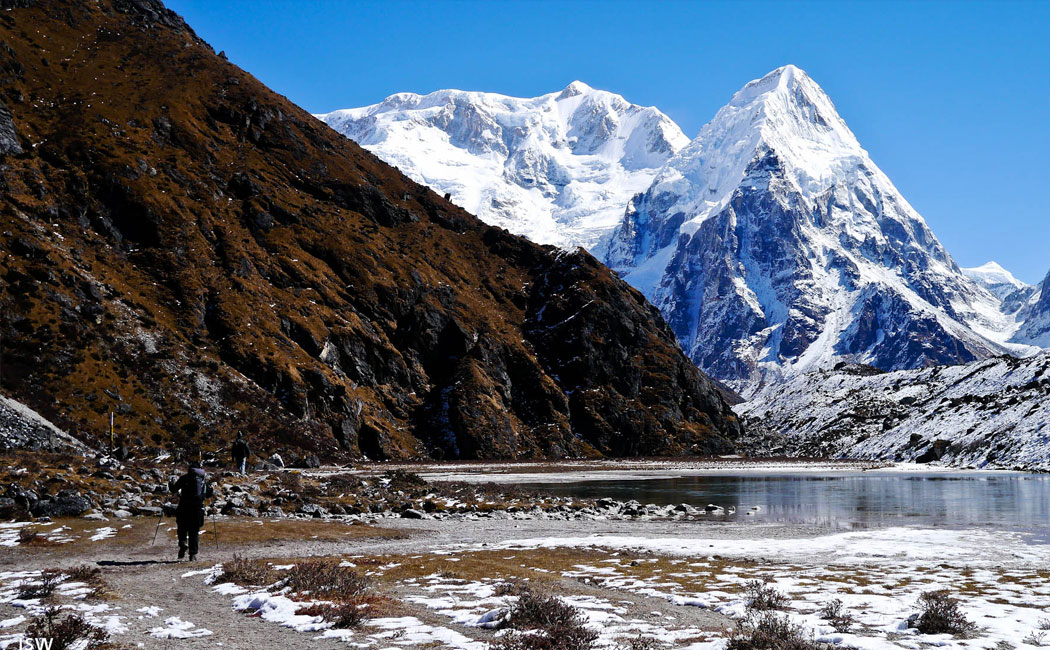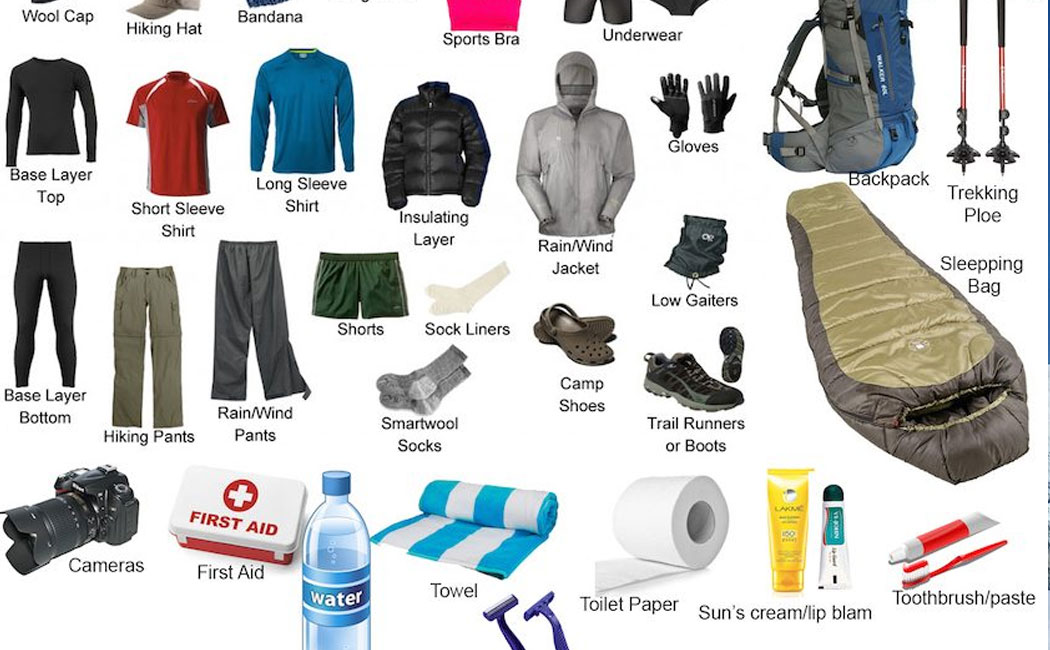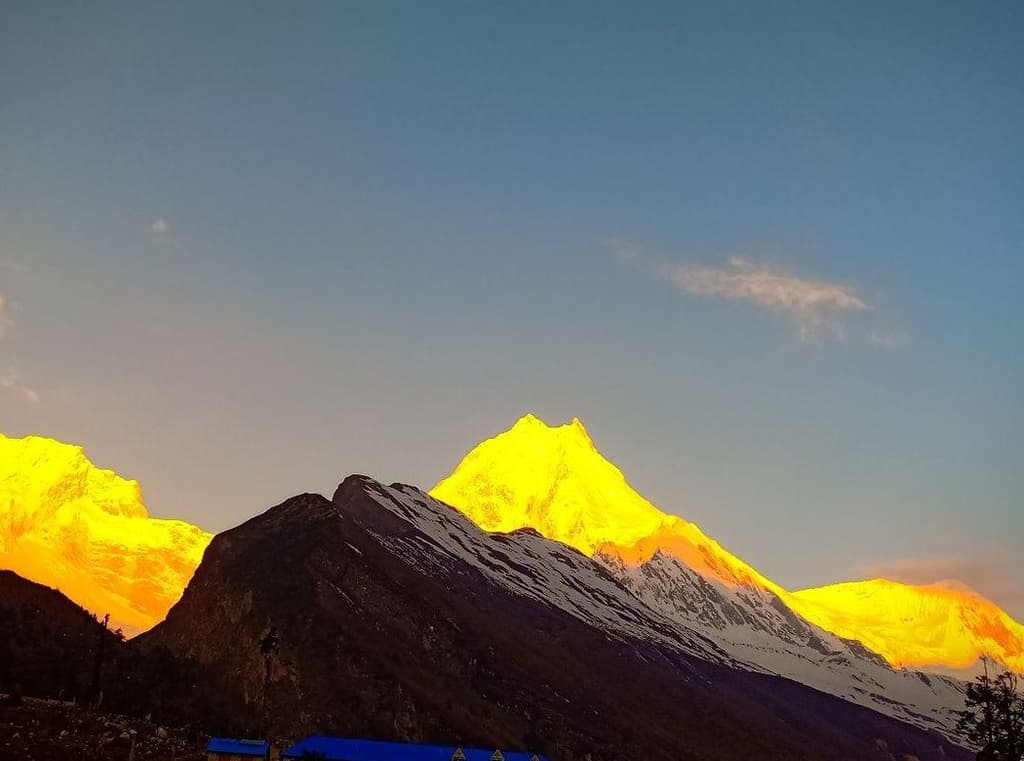
The Kanchenjunga trek in October is an unbeatable experience. The mid-autumn in the Kanchenjunga region brings ideal weather, good visibility, and, most importantly, the trails are in excellent shape. That means no obstruct on the way in wandering in the lap of the third highest mountain in the world, Kanchenjunga (8,586 m (28,169 ft)).
What’s more: the landscape on the way to Kanchenjunga Base Camp Trek in October is loaded with green meadows, rivers, lush forests of birch, rhododendron, and pine; waterfalls, the Yalung Glacier, and stunning panoramic views of the massive mountain peaks such as Everest (8848m), Lhotse (8516m), Makalu (8481m), alongside Kanchenjunga massif.
While walking deeply into nature, you may encounter various Himalayan wildlife such as Musk deer, Barking deer, Gray langur, Leopard cat, Jungle cat, Yellow-throated marten, and vulnerable species such as Clouded leopard, Himalayan black bear, and Serow. Besides, bird watching is also a popular activity. Golden-breasted fulvetta, Snow Cock, Blood Pheasant, Kalij Pheasant, Allied Warbler, Golden-breasted Tit Babbler, Snow Pigeon, Steppe Eagle, and Crossbill can cross your sight, so be attentive while on your Kanchanjunga trek in October.
People in the Kanchenjunga region are of various ethnic groups of Nepal: highland natives being the Sherpas, and lowland natives are Limbhu, Rai, Tamang, and Lepcha, among others. Though the different ethnic groups have different cultures, religions, costumes, and festivals, all celebrate the Dashain festival as their main, which is in October. And that’s what unity in diversity means.
Major Highlights of Kanchenjunga Trek in October
- Exploring the unexplored beauty of the Kanchenjunga region
- View of 8000er mountains: Everest, Lhotse, Makalu, & Kanchengunga
- Getting to the two different base camps: North and South of the 3rd highest mountain in the world-Mount, Kanchenjunga.
- Walking into the Kanchenjunga Conservation Area
- Witnessing the biggest festival: Dashain
- Low risk of Avalanche
- Stable weather to trek in the high Himalayan landscapes
Where Does Kanchenjunga Trek Start?

The starting point of the Kanchenjunga Trek in October is at Taplejung, a flight from Kathmandu to Bhadrapur. Then take a ride to Ilam and then to Taplejung. The standard itinerary for Kanchenjunga Trek in October is 27 days; however, it can be somewhat modified.
Kanchenjunga Trek Outline Itinerary
Day 1: Arrival In Kathmandu (1400m)
Day 2: A Preparation Day In Kathmandu
Day 3: 45mins flight to Bhadrapur (300 m) and 4 hours drive to Ilam town (1,365 m).
Day 4: Drive to Taplejung (1,820 m), starting point of the Kanchenjunga Trek
Day 5: Trek from Taplejung to Sinuwa (980m)
Day 6: Trek Sinuwa to Taplethok (1,380 m)
Day 7: Trek from Taplethok to Sakathum (1,575 m)
Day 8: Trek from Sakathum to Amjilosa (2,310 m)
Day 9: Trek from Amjilosa to Gyable (2,730 m)
Day 10: Trek from Gyable to Ghunsa (3,595 m)
Day 11: Rest day at Ghunsa for acclimatization
Day 12: Trek from Ghunsa to Khambachen (4,050 m)
Day 13: Trek from Khambachen to Lhonak (4,780 m)
Day 14: From Lhonak hike to Pang Pema and reach Kanchenjunga North Base Camp (5,140 m)
Day 15: Trek to Ghunsa (3,595 m)
Day 16: Trek from Ghunsa to Sele-la Kharka (4,200 m)
Day 17: Cross over Sele-la pass 4,250m and trek to Tseram (3,870 m)
Day 18: Trek to Oktang South Kanchenjunga base camp (4,730 m) and then trek to Ramche (4,580 m)
Day 19: Trek from Ramche to Tseram (3,870 m)
Day 20: Trek from Tseram to Lamite Bhanjyang (3,370 m)
Day 21: Trek from Lamite Bhanjyang to Yamphudin (1,690 m)
Day 22: Trek from Yamphudin to Phumphe (1,780 m)
Day 23: Trek from Phumphe to Kunjari (1,700 m)
Day 24: From Kunjari, trek back to Tapeljung
Day 25: Drive to Bhirtamod town.
Day 26: From Bhadrapur Airport to Kathmandu Airport
Day 27: Depart from Kathmandu
Things Need to Know About Kanchenjunga Trek in October

Kanchenjunga Weather in October
In early October, the average daytime temperature in the lower Kanchenjunga region is 10 degrees Celsius, and night has an average of 4 degrees Celsius. October offers you to walk at a comfortable temperature during the day. However, nights and mornings are freezing cold, so pack some warm clothes to prevent harsh bites of cold.
The temperature begins to drop from mid-October, and by late October, the average daytime temperature drops to 6 degree Celsius, and night has a minus temperature.
Kanchenjunga Permits
As the Kanchenjunga circuit and base camp trek lies inside the Kanchenjunga Conservation Area, a permit from the authorities is required for entry. Generally, there are two permits: Restricted Area Permit (RAP) and the other one is Kanchenjunga Conservation Area Project (KCAP) permit:
How to receive these permits? RAP can be obtained through a registered Nepali trekking agency on the side of the trekkers. It costs $20 per person/ week for the first four weeks and $ 25 per person /week if the trekkers go for the first four weeks. Permits for children under ten years of age are free.
Paying fees is not sufficient to obtain the Kanchenjunga Trek permit; you will need to show the following documents during the application process:
- Photocopy of trekkers passport
- Passport with a minimum of six months remaining validity
- Proper Kanchenjunga Trekking Itinerary
- Trekkers' agreement with the agency
- Travel insurance documents (We suggest you take insurance which covers helicopter evacuation)
- Guarantee letters of Trekking Agency
- Tax clearance certificate
- PAN Number of Trekking Agency
To acquire RAP, visit Kathmandu's Tourism service center, which is on service from Saturday to Sunday, 9 am to 5 pm.
Likewise, KCAP is acquired from the Nepal tourism board in Kathmandu, or you can receive the KCAP at the Kanchenjunga National Park checkpost during your Trekking. It costs NPR 100 per person for Nepali citizens, NPR 500 per person (US$ 5 approx) for SAARC nationals, and NPR 2000 per person (US$ 20 approx.) for other nationals.
The document for KCAP is 2 Passport-sized photos.
* Note: RAP and KCAP can be applied and collected by your trekking agency hassle-free.
Insurance
You will need travel insurance to trek in the Kanchenjunga region. Trekking in the high elevation remote area comes with various challenges, such as altitude sickness, disease, accidents, disasters, etc. Most significantly, your insurance must consist of helicopter evacuation, emergency medical, and repatriation coverage.
Insurance basically safeguards your well-being while you are trekking in a remote place far away from your family. But be careful while signing the Insurance: read carefully and save yourself from scams.
Guide & Porter

Whether solo or group, hiring a guide is mandatory for the Kanchangejunga trek in October. Hiring a guide for this trek seems useless to you at first sight, but trust us, they are very advantageous. A guide arranges your Permit documents, itinerary, accommodations, and transportation. Moreover, guides show you what you would never notice in your journey. They know all the areas well. And if anything bad happens, such as an accident, or any disaster, they make arrangements to transfer you to a safe place or helicopter evacuation if it’s in your Insurance policy. Lastly, a guide could be your new friend in a foreign country.
Now talking about porters, the porter will safely carry your bag pack. To complete the Kanchenjunga trek, you will need quite a long day, so you will probably be carrying a large backpack. At this point, you have probably known how the trial would be. Yes, it passes through remote villages, challenging mountain passes, forests, and whatnot. Even if you are a daily gym person, you might feel hard to carry a load of a bag at a high elevation. Rather than extra loads, enjoy the landscapes you encounter on the trails. Further, hiring the porter supports the local economy. Promote responsible tourism.
Challenges
Distance: Keep in your mind that the Kanchenjunga trek never comes easy hand. Though you don't need specific skills to complete Kanchenjunga Base Camp or Circuit, it is still considered a strenuous trek. Also, this trek is non-recommendable for beginners compared to Nepal's mainstream treks: Everest Base Camp, Annapurna Base Camp, or Manaslu circuit trek.
The Kanjunga Base Camp is 90 km from Taplejung, and the Kanchenjunga circuit trek takes a round of around 200 kilometers to complete. Now you know why the Kanchenjunga trek lasts for more than three weeks. You have to walk roughly 9 to 11 kilometers per day besides resting/acclamation day.
For the Kanchenjunga trek, one needs good physiques and sound physical and mental health. Since you will be spending your time in a remote area, you will be far from civilization, so have patience and be generous to locals. Surely, they will return with you good hospitality.
Elevation: Kanchenjunga trek is a high altitute trek where you land 400 to 500 meters daily. With a every meter of high altitute exposure, your body might find it hard to adapt to the new environment. So there is a high chance you will be affected with altitute sickness, which turns fatal if not treated on time.
How to cope with altitute sickness? Resting or getting down the lower elevation is the best option. Make sure you are well hydrated. If needed, take medicines. Additionally, watch what you consume. Try to eat protein and energy-giving food, which provide the strength you will require to walk the whole day. Most significantly, do not smoke and drink alcohol.
Two Base Camps: Mt. Kanchenjunga has two base camps: Kanchenjunga North Base Camp and Kanchenjunga South Camp. North Base Camp trek is the second longest. In contrast, Kanchenjunga South Base Camp Trek is the shortest.
Accommodation
Kanchenjunga trek is teahouse trek. Don't expect luxury hotels and cuisine here. On the trail, you come across small guest houses run by the locals there. The tea houses generally have 5 to 6 bedrooms with twin beds. However, the room is neat, clean, and cozy, further divided by a wooden plank only. They facilitate you with a simple bedding set: a bed sheet that covers a mattress, pillow, and blanket. Now talking about the bathroom, there is no attached toilet. Generally, the bathroom has squat toilets that are available on sharing basis.
Additionally, they provide a free cold shower, but you will be charged some dollars for the hot shower.
The highlight of the tea house is a big dining hall heated with fire at night. You can have camp firing experience at dining, talking with guides or fellow trekkers.
See more: Trekking accommodation in Nepal
Food

Despite its remoteness, you may be surprised to see the variety of food on the menu. For breakfast, the menu offers Breads, Chapatis, pancakes, varieties of eggs (omelet, hard-boiled, & scrambled), cornflakes, Muesli, and Porridge, among others.
For lunch and dinner, they serve Nepali thali set (Rice, Curry, vegetables, Pappadam, Pickles, (meat optional)), Sherpa Stew, Dhindo Set, Thupkha (Soupy noodles), Chowmein (fried noodles), fry rice, Pasta, Momo (Dumplings), Soups, Pizza, Spaghetti, Sandwiches, etc. Above all, Nepali thali set is highly recommended for trekking because it’s a perfect balance diet containing protein, carbohydrate, and vitamins.
Lastly, for beverages: tea (black, milk, masala, green, and lemon), coffee (black and milk), fruit juice, hot lemon with ginger and honey, hot chocolate, Butter tea, and local rice beer.
For desserts: they also sell pastries.
Like other things, water is expensive in the higher altitute. So get a water bottle of your own. The tea house does not charge a penny to refill your bottles over and over again. However, it would be better if you treat the water before drinking. Additionally, taking a protein bar, chocolates, instant tea, and coffee is a good option.
Electricity, Internet, & Telephone
Kanchengunja's region is powered with electricity through local hydropower and solar power. So you don't have to spend nights with the candle lights. Also, the teahouse facilitates you to charge your phone, but it might cost $2 to $3.
Regarding internet access, the service is available only at the tea houses up to the lower region, with a certain charge for WIFI use. As you ascend, there might be less chance that the tea house has internet service.
Then how to be in touch with your family after you reach a higher elevation in the Kanchenjunga region? The popular mode of communication is a satellite phone here, though it is quite expensive. Besides, you can issue a local SIM (Nepalt Telecom Service and Ncell) card after you land in Kathmandu. The SIM card also provides 3G internet data in the lower part of Kanchenjunga. Unfortunately, the upper trail of the Kanchenjunga region does not have proper network coverage.
Read more:
- Mera Peak Climbing
- Everest Base Camp Luxury Trek
- Pikey Peak Trek
- Gokyo Lakes Trek
- Everest View Trek 5 Days
Why To Trek Kanchenjunga In October?

Beautiful Weather and Climate
The weather in the Kanchenjunga region varies as you ascend. At low elevations, you may feel warm; however, once you reach the high elevation, the temperature drops a bit. Since autumn peaks in October, you will have pleasing weather with suitable temperatures to hike into the region without any difficulty.
Moreover, Autumn turns the green jungle into a vibrant, colorful wonderland. The leaves on the trees change from green to shades of orange, red, brown, and yellow, giving the forest an entirely different color palette.
See more on: Trekking Seasons in Nepal
Festive Season
October in Nepal has the biggest festivals: Dashain & Tihar. While trekking the Kanchenjunga region, you can witness Dashain celebrations among various ethnic groups following their respective traditions. You can be part of a beautiful celebration: people in the region are so generous they welcome you with a warm heart sharing their culture with you. Cultural exchange is great while you are in a foreign nation.
Stunning Himalayan View
Walking through Kanchenjunga trails is a surprise encounter of various landscapes. As you ascend high and high, you will have a close-up and breathtaking view of various mountains: Everest, Lhotse, Makalu, & Kanchenjunga, among other peaks. You will feel blessed to wake up with mountains and see stunning sunrise every day.
Stroll the old traditional Villages
The lower region of Kanchenjunga, which lies in eastern Nepal densely populated with various ethnic groups: Limbu, Rai, Tamang, Lepcha, & Sherpa. The hills are decorated with yellowish-greenish terraced fields. Further, the villages are beautifully made of wooden houses with small balconies shielded with maize drying in the sun. And mainly, you can observe people in their traditional attire who generously welcome you into their homes and teashops and give you good hospitality.
Kanchenjunga Trekking Packing List

Don’t go overboard while packing. Pack only necessary items which you will truly use during the treks:
Clothes:
- Down Jacket
- Windcheaters
- Pair of trekking trousers
- Full Sleeve t-shirt
- Half Sleeve t-shirt
- Scarfs
- Shocks
- Gloves
- Trekking Boots
- Flipflops
- Hats/caps
- Fleece Pullover or Jacket
- Waterproof Jacket
- Sports Bra (for women)
- Fleece Pants
- Thermal trouser
- Underwear
Trekking Gears
- Trekking backpack
- Duffel Bag
- Sleeping Bag
- Trekking poles
- Head torch
- Raincoat
First Aids/Medicine
- Bandage
- Antibiotics
- Painkiller
- Insect repellent
- Water purification tablets
Toiletry
- Toilet Paper
- Toothbrush
- Toothpaste
- Wet Tissue
- Soap
- Dry Shampoo
- Quick-drying towel
- Deodorants
- Nail Brush & Clippers
- Hair Brush
- Moisturizing cream
- Sunscreen
- Personal First Aid Kit
- Face Flannel
Miscellaneous Items
- Umbrella
- Extra batteries
- Multi-tools
- Solar Power bank
- Adapter
- Camera (optional)

